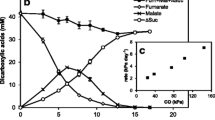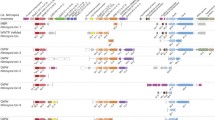Abstract
We describe the ability of carboxydotrophic bacteria for nitrate respiration or denitrification. Four out of fourteen strains examined could denitrify heterotrophically forming N2 (Pseudomonas carboxydoflava) or N2O (Pseudomonas carboxydohydrogena, Pseudomonas compransoris, and Pseudomonas gazotropha). Three carried out a heterotrophic nitrate respiration (Arthrobacter 11/x, Azomonas B1, and Azomonas C2). P. carboxydohydrogena could use H2 as electron donor for nitrate respiration under chemolithoautotrophic growth conditions. CO did not support denitrification or nitrate respiration of carboxydotrophic bacteria, although the free energy changes of the reactions would be sufficiently negative to allow growth. CO at 50 kPa was a weak inhibitor of N2O-reduction in carboxydotrophic and non-carboxydotrophic bacteria and decelerated denitrifying growth. Carboxydotrophic bacteria could utilize a wide range of N-sources. Results obtained with a plasmid-cured mutant of Pseudomonas carboxydovorans OM5 showed, that genes involved in nitrogen assimilation entirely reside on the chromosome. In the presence of an suitable electron donor, most carboxydotrophic bacteria could carry out a reduction of nitrate to nitrite that did not support growth and did not lead to the formation of ammonia.
Similar content being viewed by others
References
Alefounder PR, Greenfield AJ, McCarthy JEG, Ferguson SJ (1983) Selection and organization of electron-transfer pathways in Paracoccus denitrificans. Biochim Biophys Acta 724: 20–39
Cataldo DA, Haroon M, Schrader LE, Youngs VL (1975) Rapid colorimetric determination of nitrate in plant tissue by nitration of salicylic acid. Commun Soil Sci Plant Anal 6: 71–80
Cole JA (1988) Assimilatory and dissimilatory reduction of nitrate to ammonia. In: Cole JA, Ferguson SJ (eds) The nitrogen and sulphur cycles. Society for General Microbiology, Symposium 42. University Press, Cambridge, pp 281–329
Davis DH, Doudoroff M, Stanier RY, Mandel M (1969) Proposal to reject the genus Hydrogenomonas: Taxonomic implications. Int J Syst Bacteriol 19:375–390
Eberhardt U (1969) On chemolithotrophy and hydrogenase of a gram-positive K nallgas bacterium. Arch Microbiol 66:91–104
Fawcett JK, Scott JE (1960) A rapid and precise method for the determination of urea. J Clin Pathol 13:156–159
Frunzke K, Zumft WG (1984) Rapid single sample analysis of H2, O2, N2, NO, CO, N2O and CO2 by isothermal gas chromatography: Applications to the study of bacterial denitrification. J Chromatogr 299:477–483
Frunzke K, Zumft WG (1986) Inhibition of nitrous-oxide respiration by nitric oxide in the denitrifying bacterium Pseudomonas perfectomarina. Biochim Biophys Acta 852:119–125
Futo S, Meyer O (1986) CO2 is the first species formed upon CO oxidation by CO dehydrogenase from Pseudomonas carboxydovorans. Arch Microbiol 145:358–360
Gunatilaka MK, Allen GC, Neal JL (1983) Anaerobic, nitrate-dependent growth of Rhizobium japonicum on carbon monoxide. Abstracts, 4th International Symposium on Microbial Growth on C1-Compounds, Minneapolis, poster session II, 2–4
Hegemann GD (1984) Oxidation of carbon monoxide by aerobic bacteria. In: Crowford RL, Hanson RS (eds) Microbial growth on C1-compounds. Proceedings of the 4th International Symposium. American Society for Microbiology, Washington, DC, pp 21–25
Kemp JD, Atkinson DE (1966) Nitrite reductase of Escherichia coli specific for reduced nicotinamide adenine dinucleotide. J Bacteriol 92:628–634
Kim YM, Hegeman GD (1983) Oxidation of carbon monoxide by bacterial. Int Rev Cytol 81:1–32
Kirkconnell S, Hegemann GD (1979) Properties of bacteria that oxidize carbon monoxide as sole source of energy. Abstract of the annual meeting of the American Society for Microbiology 13, p 95
Kraut M, Meyer O (1988) Plasmids in carboxydotrophic bacteria: Physical and restriction analysis. Arch Microbiol 149:540–546
Kraut M, Hugendieck I, Herwig S, Meyer O (1989) Homology and distribution of CO dehydrogenase genes in carboxydotrophic bacteria. Arch Microbiol 152:335–341
Kristjansson JK, Hollocher TC (1980) First practical assay for soluble nitrous oxide reductase of denitrifying bacteria and a partial kinetic characterization. J Biol Chem 255:704–707
Lowry OH, Rosebrough NJ, Farr AL, Randall RJ (1951) Protein measurement with the Folin phenol reagent. J Biol Chem 193:265–275
Matsubara T, Mori T (1968) Studies on denitrification. IX. Nitrous oxide, its production and reduction to nitrogen. J Biochem 64:863–871
Meyer O (1985) Metabolism of aerobic carbon monoxide-utilizing bacteria. In: Poole RK, Dow CS (eds) Microbial gas metabolism. Academic Press, London, pp 131–151
Meyer O (1986) Biologie und Biotechnologie aerob Kohlenmonoxid-oxidierender Bakterien. In: Crueger W, Esser K, Präve P, Schlingmann M, Thauer R, Wagner F (eds) Jahrbuch Biotechnologie. Carl Hanser, München, pp 3–31
Meyer O (1989) Aerobic carbon monoxide-oxidizing bacteria. In: Schlegel HG, Bowien B (eds) Autotrophic bacteria. Springer, Berlin Heidelberg New York, pp 331–350
Meyer O, Rohde M (1984) Enzymology and bioenergetics of carbon monoxide-oxidizing bacteria. In: Crawford RL, Hanson RS (eds) Microbial growth on C1-compounds. Proceedings of the 4th International Symposium. American Society for Microbiology, Washington, DC, pp 26–33
Meyer O, Schlegel HG (1978) Reisolation of the carbon monoxide utilizing bacterium Pseudomonas carboxydovorans (Kistner) comb nov. Arch Microbiol 118:35–43
Meyer O, Schlegel HG (1983) Biology of aerobic carbon monoxide-oxidizing bacteria. Annu Rev Microbiol 37:277–310
Meyer O, Jacobitz S, Krüger B (1986) Biochemistry and physiology of aerobic carbon monoxide-utilizing bacteria. FEMS Microbiol Rev 39:161–179
Nozhevnikova AN, Zavarzin GA (1974) On the taxonomy of CO-oxidizing gram-negative bacteria. Izv Akad Nauk SSSR Ser Biol 3:436–440
Samuelson MO (1985) Dissimilatory nitrate reduction to nitrite, nitrous oxide, and ammonia by Pseudomonas putrefaciens. Appl Environ Microbiol 50:812–815
Sanjieva EU, Zavarzin GA (1971) Oxidation of carbon monoxide by Seliberia carboxydohydrogena. Dokl Akad Nauk SSSR 196:956–958
Schirmer N, Kleiner D (1989) Clostridium butyricum ammonifies nitrite, but not nitrate. FEMS Microbiol Lett 60:342–346
van Niel CB, Allen MB (1952) A note on Pseudomonas stutzeri. J Bacteriol 64:413–422
Verhoeven W, Koster AL, van Nievelt MCA (1954) Studies on true dissimilatory nitrate reduction. III. Micrococcus denitrificans Beijerinck, a bacterium capable of using molecular hydrogen in denitrification. Antonie van Leeuwenhoek J Microbiol Serol 20:273–284
Werner W (1980) Nachweis von Nitrit und Nitrat über die Bildung von Azofarbstoffen. Fresenius Z Anal Chem 304:117–124
Yordy DM, Ruoff DL (1981) Dissimilatory nitrate reduction to ammonia. In: Delwiche CC (ed) Denitrification, nitrification, and atmospheric nitrous oxide. John Wiley, New York, pp 171–190
Author information
Authors and Affiliations
Additional information
This article is dedicated to Professor Hans G. Schlegel on the occasion of his 65th birthday and in admiration for his élan and eternal idealism
Rights and permissions
About this article
Cite this article
Frunzke, K., Meyer, O. Nitrate respiration, denitrification, and utilization of nitrogen sources by aerobic carbon monoxide-oxidizing bacteria. Arch. Microbiol. 154, 168–174 (1990). https://doi.org/10.1007/BF00423328
Received:
Accepted:
Issue Date:
DOI: https://doi.org/10.1007/BF00423328




